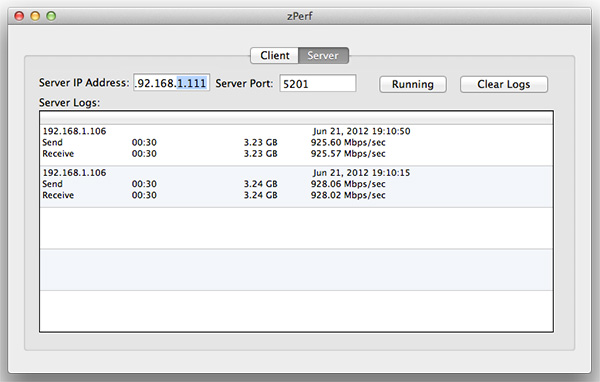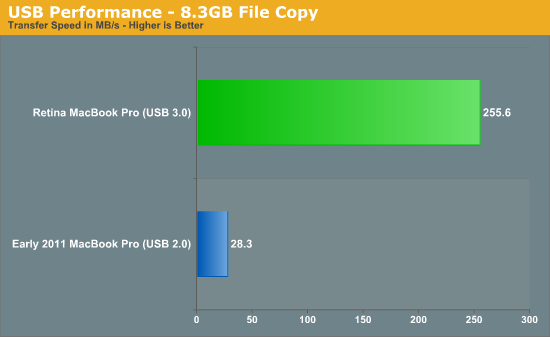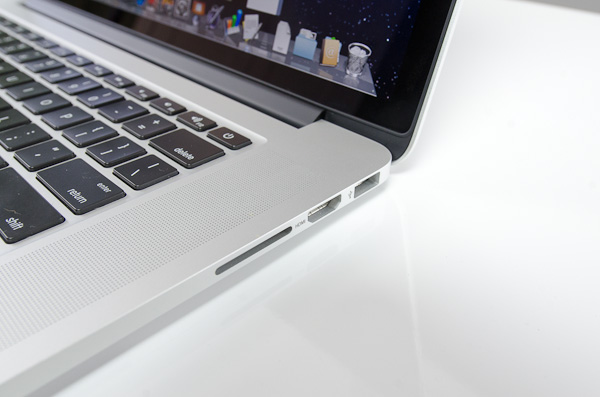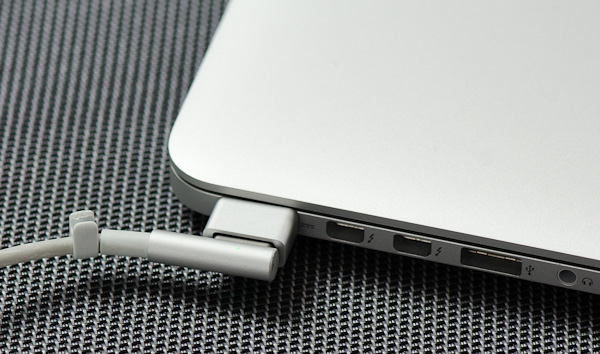The next-gen MacBook Pro with Retina Display Review
by Anand Lal Shimpi on June 23, 2012 4:14 AM EST- Posted in
- Mac
- Apple
- MacBook Pro
- Laptops
- Notebooks
Ports & Expansion
Port layout has been greatly simplified on the next-gen MacBook Pro. Along the left side there’s now a MagSafe 2 connector, two Thunderbolt ports, one USB 3.0 and one 1/8” jack for mic/headphones. The right side has the other USB 3.0 port, a full sized HDMI port and an SD card reader.
MagSafe 2 is a thinner version of Apple’s MagSafe connector, and it’s used on both the Retina MacBook Pro and the 2012 MacBook Airs. The rMBP still ships with the same 85W power adapter as before, but now with an integrated MagSafe 2 connector. In order to deal with the change in connector, Apple offers a $10 converter that allows you to plug MagSafe 1 power supplies into MagSafe 2 systems. All new Thunderbolt Displays shipping from here on out will include the MagSafe 2 converter.
The absence of an integrated Gigabit Ethernet port will surely bother some, but Apple offers a Thunderbolt to GigE adapter for $30 to accommodate. Since Thunderbolt effectively offers an external PCIe interface, there’s no performance loss if you go this route vs. the old integrated GigE connector. I was able to sustain nearly 930Mbps between the rMBP with the Thunderbolt GigE adapter and last year’s MBP:

At a price of $30 Apple is most certainly using Intel’s Port Ridge Thunderbolt controller, a cost effective single-channel TB controller without any support for DisplayPort passthrough.
USB 3.0 is provided courtesy of Intel’s 7-series chipset. Apple supports the USB Attached SCSI protocol which should allow for even better performance than what I’m showing below (with all of my focus on Thunderbolt I actually don't have a 6Gbps UASP enabled USB 3.0 dock in house):














471 Comments
View All Comments
solipsism - Saturday, June 23, 2012 - link
it seems that any major changes to their Macs will come with Retina Displays. The question is when that will come because the iMac and ATDs are likely still to difficult to create and the smaller notebooks likely require more powerful GPUs.As Anand stated Intel is committed to more powerful iGPUs, which I'm fine with as my only concern is not seeing any visual lag and I don't play games, but I do think it's feasible for the 13" MBP to get a Retina Display once that ODD is removed. The only question I have is how much additional size is required to run an IPS display with 4x as many pixels. Can we assume the same battery capacity scaling between the 15" MBP and 15' RMBP?
ananduser - Saturday, June 23, 2012 - link
There is also a price concern. The retina panel on the 15"-er incurs a considerable increase. Lower retina screens on the lesser macbooks will incur themselves a price increase(lower but an increase nonetheless).KoolAidMan1 - Saturday, June 23, 2012 - link
The logic board on the 13" MBP is tiny, not enough room for a dedicated GPU. As it stands, Apple and other ultrabook manufacturers will be leaning on integrated graphics going forward. It is the only solution with chassis getting thinner and lighter. This is a big reason why Intel has been getting so much pressure to improve their IGPs, and Haswell is looking like a huge step in that direction.ananduser - Saturday, June 23, 2012 - link
Come on...Windows supports 200% DPI scaling. By default you have 125% and 150%, but if you go custom mode you can set the DPI slider way up to 200% and any value in between(not just 100% and 200%.OSX' pre-rendering hacks and workarounds do not mean resolution independence. They have achieved a similar result only for their specific configuration. Windows is closer to that ideal as from the start you have the choice to run the native resolution and all scaling can be realized in factors between 100%-200% within that resolution frame. From a software perspective it is more agnostic, therefore more elegant. You're too selfish in your Apple desires that you don't think about custom configurations and myriad of panel choices out there.
Super56K - Saturday, June 23, 2012 - link
I would never describe windows dpi scaling as elegant.Taft12 - Monday, June 25, 2012 - link
It's quite elegant. Windows software support for DPI scaling is not.Spoony - Saturday, June 23, 2012 - link
Quartz supports fully resolution agnostic layout, transforms, and compositing on a per-object basis. It also absolutely supports real resolution independence at any scaling value you desire. See this image from Mac OS 10.4:http://origin.arstechnica.com/images/tiger/scalabl...
Your move, smartypants.
ananduser - Saturday, June 23, 2012 - link
First of all Anand doesn't seem to know Windows well enough to go beyond presets.2nd of all, past OSX implementation of scaling was 2nd rate to that of Windows. OSX was unusable on high res screen without magnifying. I don't need to search for a longstanding macrumors post that described the frustrations of being a macuser on high res(and relatively small diagonal) past desktops.
3rd: internal rendering beyond the panel resolutions and then readjusting is anything but elegant. It is a specific workaround to a specific situation of a specific machine. Apple can't expect the entire world to rework everything to fit their quirky rendering.
Spoony - Saturday, June 23, 2012 - link
That's total garbage, and I suspect you know it.OS X has gone through various stages of teething with resolution independence. It was generally workable, but not always incredibly pretty. I remember U/I cracks and other uglies aplenty. However, setting to native res on a high-res panel and upscaling to 1.25x or 1.5x was very usable and very crisp, cracks aside.
Apple has always been interested in doing resolution independence right, from OS X's beginnings and using PDF as the specification template for their drawing layer. The fact of the matter is, Mountain Lion (and Lion for now) is executing a fully resolution independent desktop, and executing it very elegantly. Much more comprehensive and capable than Windows presently.
Furthermore, Apple has built up a very nice tool set of APIs that allow it (and third parties) to create a slick experience. For now, Windows can't touch it... however, I dearly hope Microsoft fixes this right up promptly. All OSs properly handling dense displays will be a great thing going forward.
ananduser - Saturday, June 23, 2012 - link
MS has nothing to fix as W8 is great from all standpoints. It is Anand's lack of knowing Windows settings that makes him state otherwise.Apple achieved a "resolution independence" type experience through presets. It only works with their available presets and makes use weird workarounds, while obfuscating panel res choices. If you apply a certain patch on OSX, unlock resolution choice and select the native res manually(or any other res) you'll see how resolution independent OSX is not.
You're naive if you think that all the possible past and current OSX 3rd party apps will do out-of-bound patches just to match, I repeat, a specific machine and it's specific pre-rendering routines.
Resolution independence in use is completely panel and resolution agnostic. No matter the native resolution of the panel you can scale the elements by any scale you wish. You do not need to pre-render, then cut the screen to fit your panel. Both os-es lack this effectively but OSX was traditionally worse than Windows.
Note: The true idealistic notion of resolution independece does not exist. Even ios is not resolution independent, it seems so because ios works only on two, integer scaled resolutions.